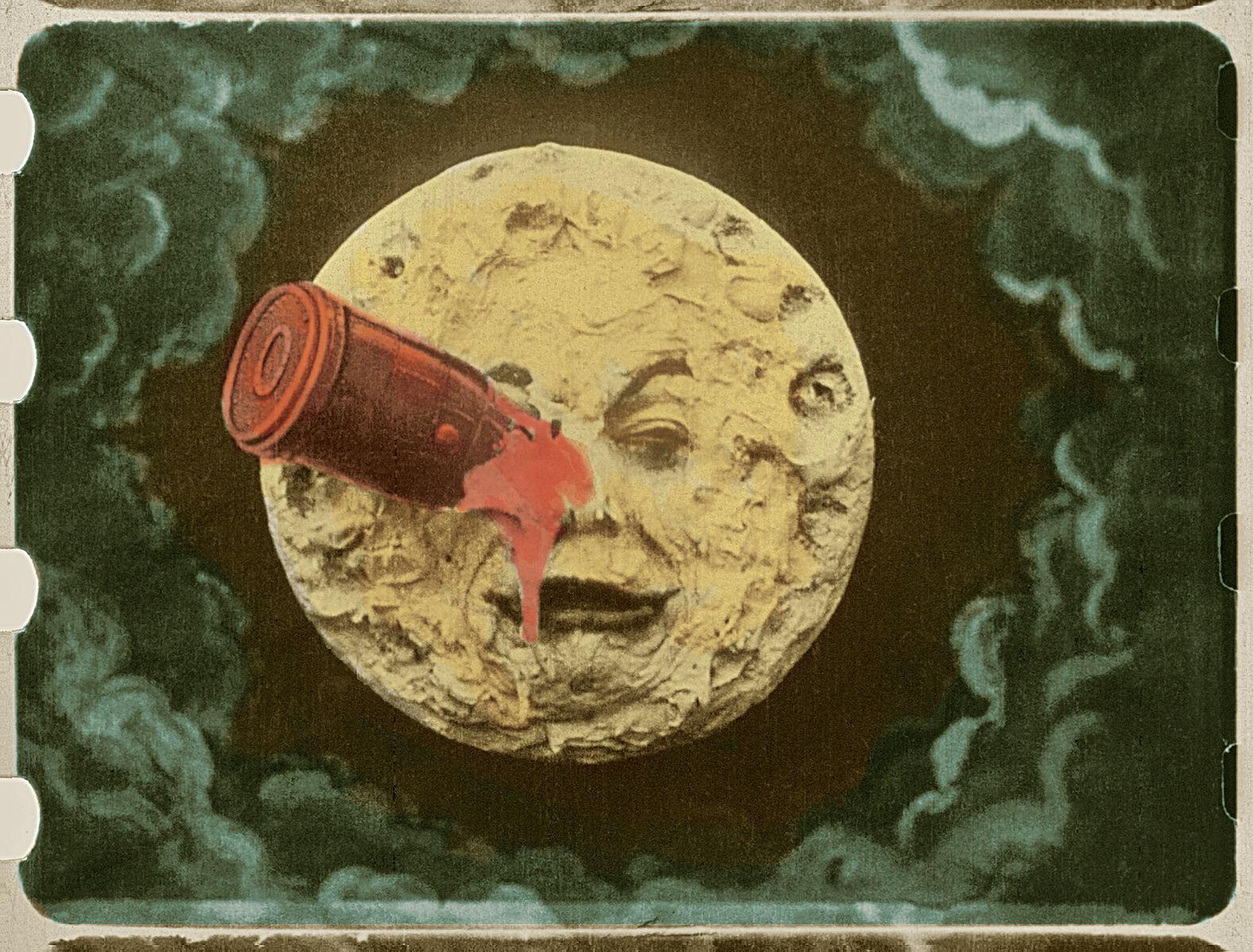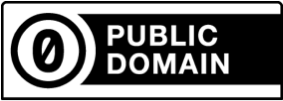2.3 The Public Domain
The public domain consists of works that are not subject to copyright. This is a vast, ever-growing pool of material on which new creativity and knowledge may be built without concern for copyright.

Melies color Voyage dans la lune, by Georges Méliès, Public Domain.
Learning Outcomes
- Explain what the public domain is
- Communicate the value of the public domain
Big Question / Why It Matters
Why is it important that works eventually fall out of copyright? Are there any works that do not qualify for copyright protection and may be freely used?
A critical aspect of copyright law is that the protection it provides does not last forever. After a set term, the copyright expires and the work enters the public domain for everyone to copy, adapt, and share without legal requirement for attribution in most jurisdictions. Likewise, there are certain types of works that fall outside the scope of copyright. Note that certain moral rights may continue to exist after copyright expires. See Section 2.1.
Personal Reflection / Why it Matters To You
Have you ever seen ancient Egyptian art in real life? Have you listened to a Beethoven symphony? These works are in the public domain. What other public domain works have you enjoyed in your lifetime? Have you ever created something new using a work in the public domain?
Acquiring Essential Knowledge
Despite the expansive reach of copyright, there is still a rich (and growing) public domain full of works which are free from copyright. Works enter the public domain in one of four ways:
1. The copyright expires.
While copyright terms are longer than ever before, they are not infinite. In most countries, the term of an individual’s copyright expires 50 years after the individual’s death. In some countries, the term is longer and can be up to 100 years after the author dies. Review the map in section 2.2, for an overview of copyright terms around the world.
2. The work was never entitled to copyright protection.
Copyright covers vast amounts of content created by creators, but certain categories of works fall outside the scope of copyright. For example, ideas and facts are not copyrightable.[1]
The Berne Convention identifies additional categories, such as official texts of a legislative, administrative, and legal nature, leaving member countries to decide if they exempt those texts from copyright protection. Most countries deny copyright for statutes, as an example. In some countries, works created by government employees are excluded from copyright protection and are not eligible for copyright.
3. The creator dedicates the work to the public domain before copyright has expired.

Creative Commons CC0 button, available for download
In most parts of the world, a creator can decide to forgo the protections of copyright and dedicate their work to the public domain. Creative Commons has a legal tool called CC0 (“CC Zero”) Public Domain Dedication that helps authors put their works into the worldwide public domain to the greatest extent possible. You’ll learn more about this tool (and other Creative Commons legal tools) later in the course.
4. The copyright holder failed to comply with formalities to acquire or maintain their copyright.
Today in most countries, there are no formal requirements to acquire or renew copyright protection over a work. This was not always the case, however, and many works have entered the public domain over the years because a creator failed to adhere to formalities.
What can you do with a work that is in the public domain?
You can do almost anything, but it depends on the scope and duration of copyright protection in the particular country where the work is used. Depending on the country, for example, a work in the public domain may still be covered by moral rights that last beyond the duration of copyright. It’s also possible that a work is in the public domain in one country, but is still under copyright in another country. This means you may not be able to use the work freely where copyright still applies.
Note: A work that is in the public domain for purposes of copyright law may still be subject to other intellectual property restrictions. For example, a public domain story may have a trademarked brand on the cover associated with the publisher of the book. Trademark protection is independent of copyright protection, and may still exist even though the work is in the public domain as a matter of copyright. Also, once a creator uses a public domain work to turn it into a new work, the creator will have copyright on the portions of their new work that are original to them. As an example, the creator of a film adaptation based on a public domain novel will have copyright protection over the film but not the underlying public domain novel.
Finding works in the public domain
With millions of creative works whose copyright has expired—and many more added regularly with tools like the CC0 Public Domain Dedication, the public domain is a vast treasure trove of content.
Some sites that host works in the public domain are Project Gutenberg, Public Domain Review, Digital Public Library of America, Wikimedia Commons, Internet Archive, Library of Congress, Flickr, Europeana, the Smithsonian, the Auckland Museum and the Rijksmuseum.[2]
It is not always easy to identify whether a work is in the public domain (though there are many resources available to help). As we learned, copyright protection is automatic, so the absence of a copyright symbol “©” does not mean a work is in the public domain. In addition to its CC0 Public Domain Dedication, Creative Commons also has a tool called the Public Domain Mark, which can label works whose copyright has expired everywhere in the world. While the mark does not have legal effect, it ideally helps reusers identify works in the worldwide public domain.
For more confidence that a work is in the public domain look for the Public Domain Mark or the CC0 symbol for reusing public domain works.
Author credit and the public domain
In countries where moral rights don’t expire, you have to credit the author of the work even if the work is in the public domain. And even though it may not be legally required in every country, there are many benefits to identifying and giving credit to the original creator, even after that creator’s work has entered the public domain. Can you think of a reason why it might be required to give credit to an author whose work is in the public domain? Can you think of why norms should be encouraged when public domain works are reused?
Many communities have adopted norms, which are accepted good practices for crediting the authors and the treatment of works in the public domain. Creative Commons has created public domain guidelines that can be used by communities to create their own norms. Review the CC Public Domain guidelines.
If the work was digitized by a GLAM institution, it is also good practice to identify the provenance of the artwork by crediting the GLAM institution, and when possible, providing a link that goes back to the GLAM institution. We will explore more of this when we talk about the TASL approach in Unit 4. If you are a GLAM institution, you can re-use and adopt the Public Domain Guidelines to clarify to your users how you would like the work to be attributed. It is also a good idea to provide examples and good guidance for your users.
Are you curious on how you might credit a work on social media? Read this summary of a conversation between staff of Europeana, The Getty and the Indianapolis Museum of Art around what they do on their social media accounts with artworks.
Indigenous cultural heritage/traditional cultural expressions
In some instances, cultural heritage elements that are considered in the public domain under copyright law might be subject to other considerations or restrictions that need to be taken into account. This is especially the case of cultural works, sacred objects, rituals, or other types of traditional cultural expressions and knowledge created by and under the custodianship of Indigenous peoples or local communities.
To be clear, these traditional cultural expressions might not be protected by copyright. However, this doesn’t mean that they are necessarily free for reuse or posting on the internet. In view of the cultural rights or interests and customary laws or protocols that might govern their access and use, these cultural expressions deserve to be treated respectfully. It is recommended not to post them online or allow their re-use without prior consultations with the community(ies) that are their custodian.
Cultural institutions have an important role to play to ensure the traditional cultural expressions in their collections are used respectfully and according to the wishes of their holders. Specific platforms, like Mukurtu, and labels, like the Traditional Knowledge Labels, can help. See this video from Local Contexts for more considerations around traditional knowledge and copyright. Local Contexts offers digital strategies for Indigenous communities, cultural institutions and researchers through the TK (Traditional Knowledge) & BC (Biocultural) Labels and Notices.
If you are interested in exploring this topic in more detail, you can read the outcomes of the desk-based research that Creative Commons conducted on Open Culture policies for Traditional Cultural Expressions on this blog post: “Sharing Indigenous Cultural Heritage Online: An Overview of GLAM Policies”.
Ethical considerations
There might be other cases when a work is not protected by copyright, but you might still want to be careful in the way in which you use it or make it available. For example, issues of privacy, depictions of dead bodies or human remains, scenes of violence, or other culturally or morally sensitive issues must be considered when re-using public domain works. Use your own judgment or refer to established norms whether the use of a work might be harmful to others, inadequate without additional context, or disrespectful of context.
CC licenses don’t apply where copyright doesn’t apply, rendering them ineffective to protect the work from potentially controversial or harmful re-use. Alternatives include using ethical statements or labels to point to restrictions outside of copyright.
Final remarks
A healthy public domain is crucial to preserving our cultural heritage, inspiring new generations of creators, and increasing human knowledge. Because the scope and duration of copyright has grown so much over the years, it can be easy to forget the public domain exists at all. Works in the public domain are incredible resources that belong to all of us.
- As another example, U.S. government works are not protected by copyright law, according to Section 105 of U.S. Copyright Law. Unless they fall under certain exceptions, U.S. government works are in the public domain because the works are considered public resources. ↵
- If you are curious to know the list of all cultural heritage institutions (galleries, libraries, archives and museums, or GLAMs) that have released collections that are in the public domain, check this regularly updated survey by Douglas McCarthy and Andrea Wallace. ↵